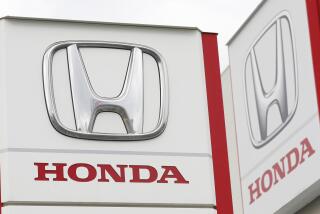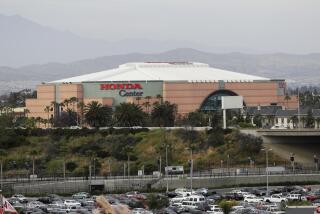Honda Hopes ’94 Accord Will Return It to Driver’s Seat : Autos: The Japanese company that once dominated U.S. sales has lost leadership to rivals. But executives say they are confident of reversing the decline with the new Accord.
- Share via
MARYSVILLE, Ohio — On the U-shaped No. 2 assembly line at the Honda auto plant near this country town, employees dressed in white uniforms feed stamped metal panels into a row of welding robots.
With each weld, a spray of sparks rains down. Amid the tangle of complex machinery, the skeleton of another car is fused together. At the end of the line, a steady procession of 1993 Honda Accords emerges.
But this week, a new-generation Accord will move onto the line--and with it the hopes of Honda in America.
Never before has Honda Motor Co., long considered the star Japanese performer in the United States, faced such pressure to produce a winner.
“If the new Accord is unsuccessful, it would be a significant problem,” acknowledges Tom Elliott, executive vice president of auto operations and Honda’s top U.S. official.
The reason is that Honda’s sales have slumped as the competition has grown and its rivals’ cars have improved.
Worldwide, the company’s profit dropped 41% to $344 million for the year ended March 31. Its first-quarter net earnings fell 62% to $57 million, due largely to slumping auto sales in North America.
So far this year, Honda’s U.S. sales have fallen 10%. Its share of the U.S. car market has declined to 6.5%, from almost 10% in 1991.
And the Accord--America’s best-selling car from 1989 to 1991, accounting for 60% of Honda’s U.S. sales last year--is now ranked fourth.
Some analysts criticize Honda for becoming too stodgy in its styling. (The Accord’s design has changed little since its introduction in 1976.) Others say it has fallen behind in marketing, where much of the battle is waged today.
Moreover, Honda lacks vehicles in the fast-growing truck segment, and the company is just now scrambling to produce a minivan and a sport-utility vehicle.
“The heyday is over for Honda,” says Susan Jacobs, an auto industry analyst based in Little Falls, N.J.
Most observers, however, say the rumors of Honda’s demise have been greatly exaggerated.
The company’s products continue to rank high on quality surveys. Honda’s customers are remarkably loyal. And the firm remains on the cutting edge of manufacturing processes.
“They have stumbled, but it would be a mistake to count them out,” said Chris Cedergren, a forecaster for AutoPacific Group in Santa Ana.
There is little question that the past year has been a difficult one for Honda.
* In November, the Big Three auto makers kicked Honda out of the Motor Vehicle Manufacturers Assn., re-christening the group the American Automobile Manufacturers Assn., the prime lobbying entity for U.S. manufacturers.
Honda--which portrays its U.S. unit as an American company--took offense at the unilateral action. The company employs 16,000 U.S. workers and builds in Ohio more than 70% of the cars it sells in the United States.
* The Ford Taurus knocked the Accord off its perch as the best-selling U.S. car. Taurus outsold the Accord 409,751 to 393,477 last year.
Sales have continued to slump this year, with the Accord now behind the Taurus, Toyota Camry and Chevrolet Cavalier, although Accord sales have gotten a boost lately from dealer incentives of $1,000 to $1,500 a vehicle.
* The yen has strengthened about 17% against the dollar in 1993, putting pressure on Honda--like other Japanese car makers--to raise prices.
Honda claims it is better shielded from currency fluctuations than its Japanese competitors because of its extensive U.S. production and reliance on U.S. parts suppliers. But it still imported from Japan more than 25% of the vehicles it sold in America last year.
* The company was rocked earlier this year by several lawsuits charging that dealers had paid bribes to Honda executives to obtain cars during the days of heavy demand. Honda dismissed several regional sales executives accused of accepting illegal payments. Analysts said the scandal has largely been contained and that damage to customer relations was minimal. * Honda has recalled 1.8 million 1983-87 vehicles to fix defective fuel filler pipes that could cause gasoline leaks and fires. The recall is the largest in the firm’s history and could cost the company an estimated $15 million to $20 million.
Despite these problems, Honda remains a formidable force in the U.S. auto industry.
A corporate maverick first known worldwide for its motorcycles, Honda began exporting cars to America in 1970.
Long before protectionist sentiment and a strong yen became major concerns, it decided to build manufacturing plants in the United States. Indeed, Honda is now the leading U.S. exporter of autos, producing right-hand drive vehicles for Japan on the same line it produces left-hand drive cars for U.S. consumers.
Along the way, the company proved that U.S. workers could produce automobiles of equal quality to those made in Japan. It continues to apply principles of employee empowerment in its auto plants in Marysville and East Liberty, Ohio, and at an engine plant in nearby Anna.
Even with its sales and earnings slump--problems it shares with the other Japanese auto makers--Honda has resisted laying off assembly workers.
Honda will not unveil the 1994 model until Wednesday, with showroom sales beginning Sept. 8. Company officials said the car will have a new look and offer improved fuel efficiency, reduced noise and vibration and an enhanced interior. It will be introduced with a four-cylinder engine, but a more powerful V-6 will be available next year.
Those who have seen the car give it high marks. While it is not a dramatic departure from past Accords, they say, it has enough styling and quality enhancements to be a strong contender in the increasingly competitive mid-size market.
The key to success is price.
“Our target is to shoot for the same price as our ’93 models,” Elliott said in an interview earlier this month at Honda’s new proving grounds in the Mojave Desert, about 100 miles north of Los Angeles.
That would put the car in the range of $14,500 for the base two-door coupe, with the top-of-the-line, four-door sedan going for about $19,500. Company officials said competition mandates that the price be kept below $20,000.
Honda is vying for market share with several strong contenders from both Detroit and Japan. Ford’s Taurus continues to sell well, and Chrysler’s LH series--the Chrysler Concorde, Dodge Intrepid and Eagle Vision--have been well received. Nissan’s Altima has enjoyed brisk sales, Toyota’s Camry continues its strong performance, and both Mitsubishi’s Galant and Mazda’s 626 are viable rivals.
Even General Motors, whose mid-size models are aging, is seen as a possible threat to Honda because of aggressive pricing. For instance, GM is offering its Pontiac Grand AM SE coupe, with a full package of options, for $13,995 in California. That is $2,875 less than a comparably equipped Accord DX.
Detroit’s low-price strategy has increased the pressure on Honda, which raised prices three times in the 1993 model year. In addition, there has been a perceptible narrowing of the quality gap between Honda and its rivals.
“Honda’s poor performance this year is a signal of the fundamental change in the U.S. auto market,” said Jacobs, the New Jersey analyst. “It means Honda will not be able to regain dominance in the mid-size segment on quality alone.”
The company plans to hold the line on prices by cutting costs in its production process, already considered among the leanest in the industry.
Bob Simcox, manager of the Marysville plant, is counting on substantial savings in tooling and labor costs because of minimal line changes needed to produce the new Accord.
Honda officials emphasize that the new Accord was designed both by U.S. and Japanese engineers. From the Marysville plant, 65 employees and their families were sent to Japan to work on the project.
“In the past, we reacted to design changes,” said assistant plant manager Kim Smalley, who spent two years in Japan. “Now we get involved before it happens.”
While Honda is renowned for its production acumen, some critics say success has led it to neglect its dealerships and marketing.
There seemed little need for aggressive salesmanship when people were on waiting lists for cars. But Elliott says those days are over. The company has expanded its sales training for dealers, beefed up its financing arm, begun offering dealer incentives and put new emphasis on leases.
The new Accord’s $75-million advertising campaign begins this week with teaser ads showing an empty road. The camera focuses on the median strip, zooming in to focus on a fork in the road.
The ads aptly capture Honda’s current state: It is truly at an important juncture.
Besides the challenge to its bread-and-butter Accord, Honda is up against strong rivals to its Civic subcompact and its luxury Acura models, the Integra and Legend.
The Civic, which was redesigned in 1992, has been the one bright spot for Honda this year. Sales are up nearly 25% in the first seven months of 1993.
But Chrysler’s new Neon subcompact, due out in January, could sell for $2,000 less than the Civic. And GM is planning to gear up production of its popular Saturn, which has been in short supply.
Meanwhile, sales of the redesigned Prelude, Honda’s two-door sports coupe, are down 34% this year.
Honda led the Japanese entry into the luxury car market in 1986, its Acura models scoring a huge success against Germany’s upscale BMWs and Mercedes-Benzes. But Acura sales have been off for the last two years--down nearly 14% through July of this year--largely due to competition from Toyota’s Lexus and Nissan’s Infiniti divisions.
Honda is also trying to fill the gaps in its lineup. It will come out next year with a sport-utility vehicle built by Isuzu, the first Honda-badged vehicle not produced by the company.
Before it rolls out a planned minivan in 1995, Honda faces tough choices about a production site. If the vehicle is built in Japan, Honda will have to pay a 2.5% import tariff and contend with fluctuations in the yen. If it is built here, the company may face a factory capacity problem--particularly if the new Accord is a hit.
Honda officials figure the company can sell 360,000 Accords annually. While that may not be enough to regain the bestseller crown, it would clearly maintain the Accord’s standing as a major player.
“If they don’t get out of this down cycle with the Accord,” said Cedergren, “there will have to be some pretty significant changes.”
Elliott responds that Honda is not down for the count.
“Talk is talk,” he said, watching a new Accord zip past on the oval test track, the California desert and rugged mountains behind it. “Our sales are still good, by anybody’s standards. We will improve the rest of this year and have a good year next year.”
Honda’s Struggles
After riding high for years on sales of the popular Accord, Honda Motor co.’s fortunes are slipping. The Japanese car maker is hampered by the growing strength and improved quality of its mid-size competition; a narrow model line that leaves it out of the growing truck and sport-utility markets, and lagging consumer interest in cars that seem little changed from year to year.
Profits have fallen...
Worldwide earnings (for fiscal years ended March 31, in billions of yen)
1993: 38
...as sales, by several measures, have sagged.
Net sales (for fiscal years ended March 31, in billions of yen)
1993: 4,132
North American auto sales (for fiscal years ended March 31, in billions of yen)
1993: 1,542
Unit sales (for fiscal years ended March 31, in thousands)
North America:
1993: 794
Worldwide:
1993: 1,793
U.S. Accord sales
1992: 393,477
Source: Honda Motor Co.






